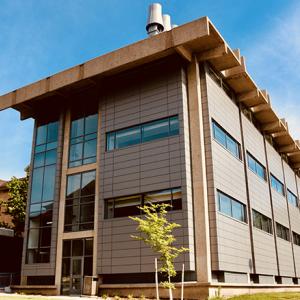Please address
inquiries to:
Email: donald.umstadter@unl.edu
Capabilities
Located on three floors of the Behlen Lab building on the UNL city campus. Laboratories meet stringent requirements on temperature (±1 C), humidity (5%), and vibration control, made possible by separate designated electrical, processed-chilled-water, and air-handling systems.
Three separate and independent laser systems: (1) Diocles-Peak power from 0.2 - 0.7-PW at 0.1-Hz repetition rate, (2) Diocles high rep. rate- Peak power 100-TW at 10-Hz (3) Archimedes- Peak power 10-TW at 10-Hz. Ti:sapphire chirped-pulse amplification lasers operating at 800-nm in 30-fs duration pulses.
Real-time measurement and optimization at full power of pulse characteristics on target: energy, contrast, and spatial mode.
Three each. Two are radiation-shielded for radiological safety.
High-vacuum, sized 72”x48”x24”. Motor-driven and remotely-operable optical mounts.
Independent pulse compression systems allow for independent control of pulse durations of dual and separate beams used in same experiment. Wavefront sensors and deformable mirrors control spatial phase. Spatial and temporal active feedback control provides consistent transform-limited pulses and diffraction-limited focusing at interaction. High numerical aperture focusing optics allow highly relativistic intensities to be achieved with laser light of either or both the fundamental frequency (800 nm) or its second harmonic (400 nm).
Synchronized laser-wakefield-driven, quasi-monogenetic 100-400 MeV electron beams. (Note: Due to the complexity of this capability, it is provided by the facility only for collaborative experiments.)
Synchronized x-rays (10 keV – 10 MeV) from bremsstrahlung, K-alpha, betatron, or Compton scattering. (Note: Due to the complexity of this capability, it is provided by the facility only for collaborative experiments.)
Remote monitoring and control of laser and experimental parameters.
1 senior scientist, 2 technicians, 1 lab manager, 1 administrative coordinator assist users with safe and effective experimental campaigns. Trained laser-safety officer responsible for safety training and accountability. State-licensed accelerator facility, with radiation-safety monitoring and training.
Operational procedures comply with EAR and ITAR export control regulations. In-house machine and electrical shops.
Ample office space. Downtown Lincoln city-campus location offers a wide variety of housing, restaurants, and entertainment walking distance from the laboratory.
https://www.unl.edu/diocles/home
Donald Umstadter, donald.umstadter@unl.edu
| Parameter | Value | Unit | Additional Information | |||
|---|---|---|---|---|---|---|
| Center Wavelength | 810 | nm | ||||
| Pulse duration (I FWHM) | 30 | fs | ||||
| Max energy on target | 0.3 | J | ||||
| Shot energy stability | 10 | % | r.m.s. | |||
| Focal spot at target | ||||||
| F/number | f/2 | |||||
| intensity FWHM | 2 | μm | ||||
| Strehl ratio | 0.9 | |||||
| Energy containment | 90 | % | within | 3.6 | µm | radius |
| F/number | f/25 | |||||
| focal spot FWHM | 50 | μm | ||||
| Strehl ratio | 0.9 | |||||
| Energy containment | 90 | % | within | µm | radius | |
| Pointing Stability | 25 | μrad | ||||
| Pre-pulse contrast | ||||||
| ns scale | 10-10 | @ | 2 | ns | ||
| ps scale | 10-8 | @ | 175 | ps | ||
| Repetition Rate | 10 | Hz | ||||
| Parameter | Value | Unit | Additional Information | |||
|---|---|---|---|---|---|---|
| Center Wavelength | 805 | nm | ||||
| Pulse duration (I FWHM) | 30 | fs | ||||
| Max energy on target | 20 | J | ||||
| Shot energy stability | 10 | % | r.m.s. | |||
| Focal spot at target | ||||||
| F/number | f/1 | |||||
| intensity FWHM | 1 | μm | ||||
| Strehl ratio | 0.9 | |||||
| Energy containment | 90 | % | within | 3.6 | µm | radius |
| F/number | f/15 | |||||
| focal spot FWHM | 20 | μm | ||||
| Strehl ratio | 0.9 | |||||
| Energy containment | 90 | % | within | 36 | µm | radius |
| Pointing Stability | 25 | μrad | ||||
| Pre-pulse contrast | ||||||
| ns scale | 10-10 | @ | 2 | ns | ||
| ps scale | 10-8 | @ | 175 | ps | ||
| Repetition Rate | 0.1 | Hz | ||||
| Parameter | Value | Unit | Additional Information | |||
|---|---|---|---|---|---|---|
| Center Wavelength | 805 | nm | ||||
| Pulse duration (I FWHM) | 30 | fs | ||||
| Max energy on target | 3.5 | J | ||||
| Shot energy stability | 5 | % | ||||
| Focal spot at target | ||||||
| F/number | f/2 | |||||
| intensity FWHM | 2 | μm | ||||
| Strehl ratio | 0.9 | |||||
| Energy containment | 90 | % | within | 3.6 | µm | radius |
| F/number | f/15 | |||||
| focal spot FWHM | 20 | μm | ||||
| Strehl ratio | 0.9 | |||||
| Energy containment | 90 | % | within | 36 | µm | radius |
| Pointing Stability | 10 | μrad | ||||
| Pre-pulse contrast | ||||||
| ns scale | 10-9 | @ | >1 | ns | ||
| ps scale | 5x10-10 | @ | 175 | ps | ||
| 3x10-8 | 1 | ps | ||||
| Repetition Rate | 10 | Hz | ||||
Contacts
Please address
inquiries to:
Email: donald.umstadter@unl.edu
News, Events & Publications
